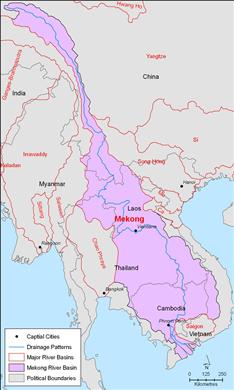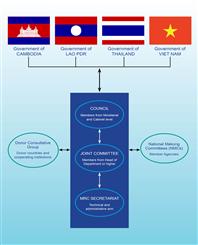The Mekong River basin covers a land area of approximately 795 000 km² and a combined population of over 70 million in six countries—China, Myanmar, Lao PDR, Thailand, Cambodia, and Viet Nam. The Mekong River flows 4 909 km from its headwaters in the Tibet Plateau through six distinct geographic regions on its journey to the South China Sea . The region faces pressure from a number of environmental issues, and large-scale development projects are at different stages of planning and implementation
The Mekong River Commission (MRC) was established through the 1995 Agreement on the Cooperation for the Sustainable Development of the Mekong River Basin signed by the governments of Cambodia, Lao PDR, Thailand and Viet Nam. The two upper states of the Mekong River Basin, the People’s Republic of China and the Union of Myanmar, are dialogue partners to the MRC.
The MRC replaced the Mekong Committee, which was established in 1957 as the Committee for Coordination of Investigations of the Lower Mekong Basin . The 1995 Agreement stipulates that the riparians should utilise the river system in a reasonable and equitable manner. The MRC supports a joint basin-wide planning process with the four countries, called the Basin Development Plan, which is the basis of its Integrated Water Resources Development Programme. The MRC is also involved in fisheries management, promotion of safe navigation, irrigated agriculture, watershed management, environment monitoring, flood management and exploration of hydropower options.

The Mekong River basin.
( click to enlarge )
The MRC comprises three permanent bodies: the Council, the Joint Committee (JC) and the Secretariat. The Council consists of one member from each country at ministerial or cabinet level, and is responsible for the overall governance of the Mekong River Commission. The Council makes policy decisions and promotes and supports co-coordinating joint activities and programmes in order to implement the 1995 Agreement . The National Mekong Committees coordinate MRC programmes at the national level and provide links between the MRC Secretariat and the national ministries and line agencies. The principal implementing agencies of the MRC programmes and projects are the line agencies of the riparian countries in the Lower Mekong Basin. They are served by the respective National Mekong Committee Secretariats in each country.
There are some important lessons to be learned from the experiences of the Mekong River basin. Firstly, the presence of a strong institution that is resilient over time, even during times of conflict, is one of the most important factors leading to cooperation (Giordano and Wolf 2003). The Mekong Committee continued to operate and exchange information throughout the Viet Nam War, illustrating the strength and resilience of the institution. Secondly, the downstream Mekong countries have come together under the MRC, despite the lack of involvement of China as the upstream country. Their unified front has led to a number of cooperative initiatives of the lower Mekong states. Since 1996, this cooperation of the lower Mekong states has led to greater involvement of China and Myanmar as Dialogue Partners.
In 2002, the People's Republic of China signed an agreement on the provision of hydrological information on the Lancang/Mekong River. Under this agreement China provides water level data in the flood season from two stations located on the Upper Mekong in China. This information is an input into the MRC's flood forecasting system, and talks are in progress to expand this involvement .
 Organisational structure of the MRC. Source:adapted from MRC 2009 ( click to enlarge ) |
